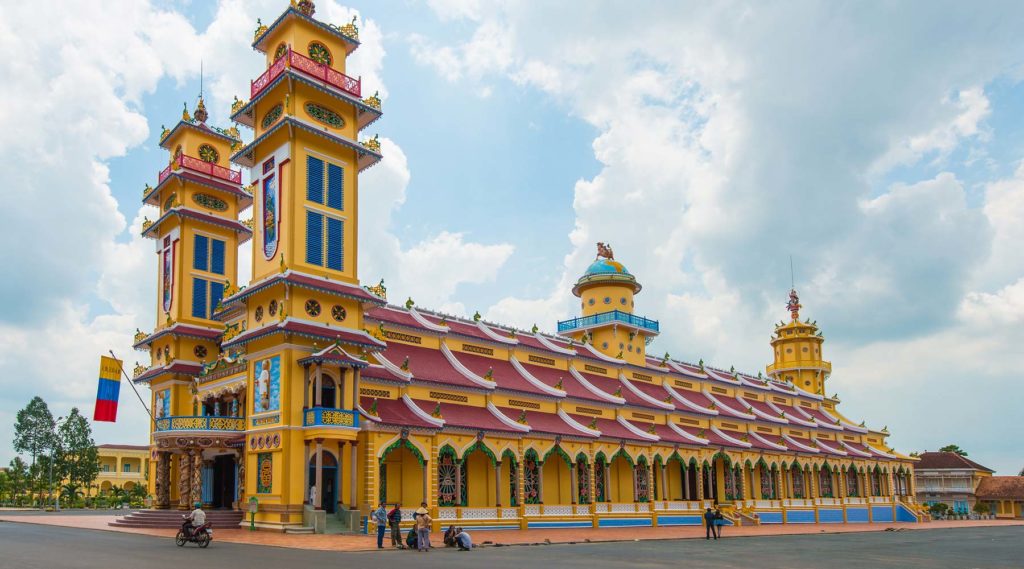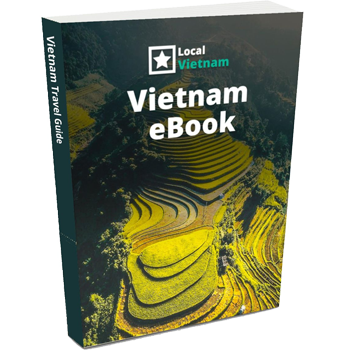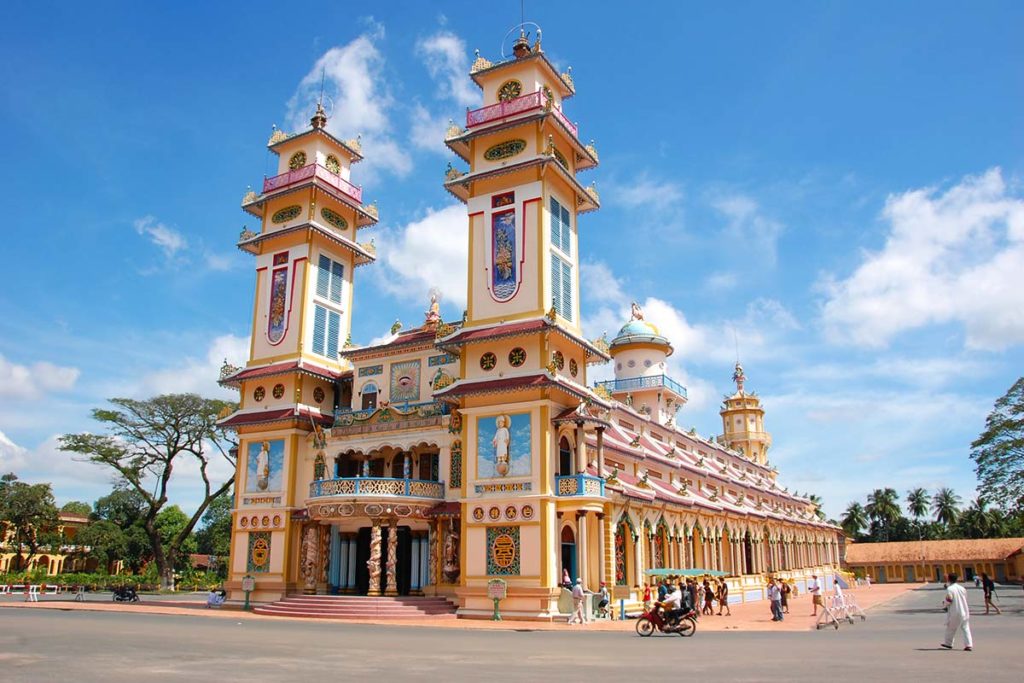What is the Tay Ninh Holy See?
The Tay Ninh Holy See is the headquarters of the Cao Dai religion and the largest Cao Dai temple in the world. Built on a vast complex of around 100 hectares in Tay Ninh Province, the site includes the Great Divine Temple, administrative buildings, living quarters for clergy, gardens, and smaller shrines.
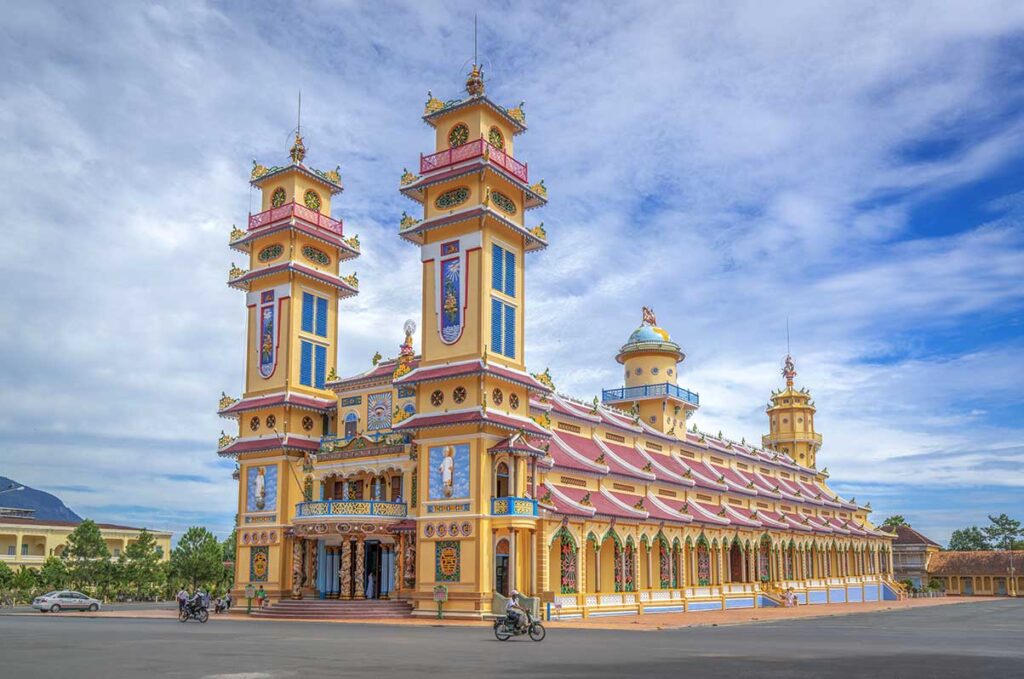
What makes it unique is both its size and its role: this is the spiritual center of a religion founded in Vietnam in the 1920s, which blends teachings from many of the world’s major faiths. The Great Divine Temple itself is the main attraction, a long, colorful building with dragon-covered columns, starry ceilings, and the famous Divine Eye symbol. Surrounding it, the spacious grounds give the feel of a religious city rather than just a single temple.
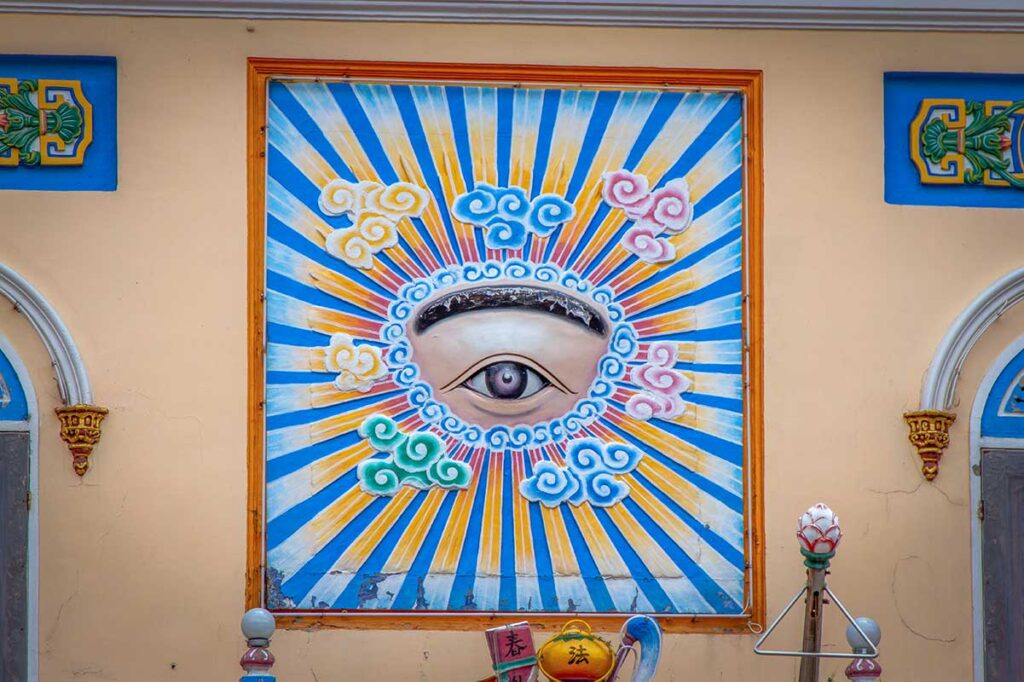
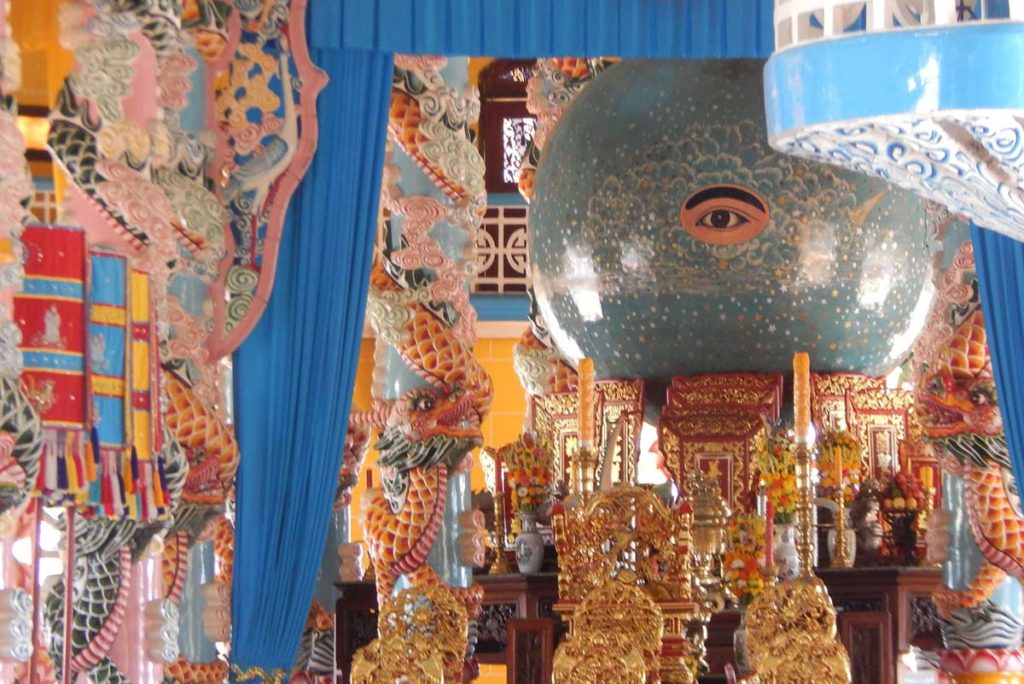
For most travelers, visiting the Tay Ninh Holy See is less about sightseeing dozens of monuments and more about experiencing this unusual mix of architecture, symbolism, and religious ceremony all in one place.
About the Cao Dai Religion
Caodaism is one of Vietnam’s youngest religions, founded in Tay Ninh in 1926. Its aim was to bring together the best elements of the world’s major faiths into a single belief system. As a result, you’ll find influences from Buddhism, Christianity, Confucianism, Taoism, Hinduism, and even Islam in its teachings and practices.
Caodaists believe in one God, represented by the symbol of the Divine Eye inside a triangle. This eye appears throughout the Tay Ninh Holy See and other Cao Dai temples. The religion also has a structured hierarchy, headed by a Pope. While the highest clergy positions are male, many women serve as lower-level clergy, and gender separation is visible during ceremonies (men on the right, women on the left).
Cao Dai clergy are vegetarian and practice celibacy, while lay followers are encouraged to eat vegetarian meals at least ten days a month. Today, the religion counts millions of followers, mainly in southern Vietnam and the Mekong Delta, but it has also spread to overseas Vietnamese communities in the United States, Australia, and Europe.
History of Tay Ninh Holy See
Construction of the Tay Ninh Holy See started in the 1930s, but financial and political difficulties delayed progress. Work began in earnest in 1936, and the Great Divine Temple was finally completed in 1955 after nearly two decades of interruptions. The result was a massive complex that became the official center of the Cao Dai religion.
During World War II, the Cao Dai leadership even raised its own militia, which fought against the Japanese occupation. In the turbulent years that followed, the religion and its leaders clashed with both French colonial forces and the South Vietnamese government. Prime Minister Ngo Dinh Diem dissolved the Cao Dai army in the 1950s, and later, after 1975, the new communist government suppressed Cao Dai activities for a decade. Only in 1985 was the religion fully legalized again.
Today, the Tay Ninh Holy See remains the spiritual headquarters of Caodaism and a major pilgrimage site. While it is open to tourists, its primary purpose is still religious, with ceremonies held daily and major festivals attracting thousands of followers from across Vietnam.
Highlights of Visiting Tay Ninh Holy See
The Tay Ninh Holy See is not just one building, but a large religious compound with several areas worth noticing. The Great Divine Temple is the main draw, but walking around the grounds also gives you a sense of how big and active this place is for followers of Caodaism.
1. The Great Divine Temple
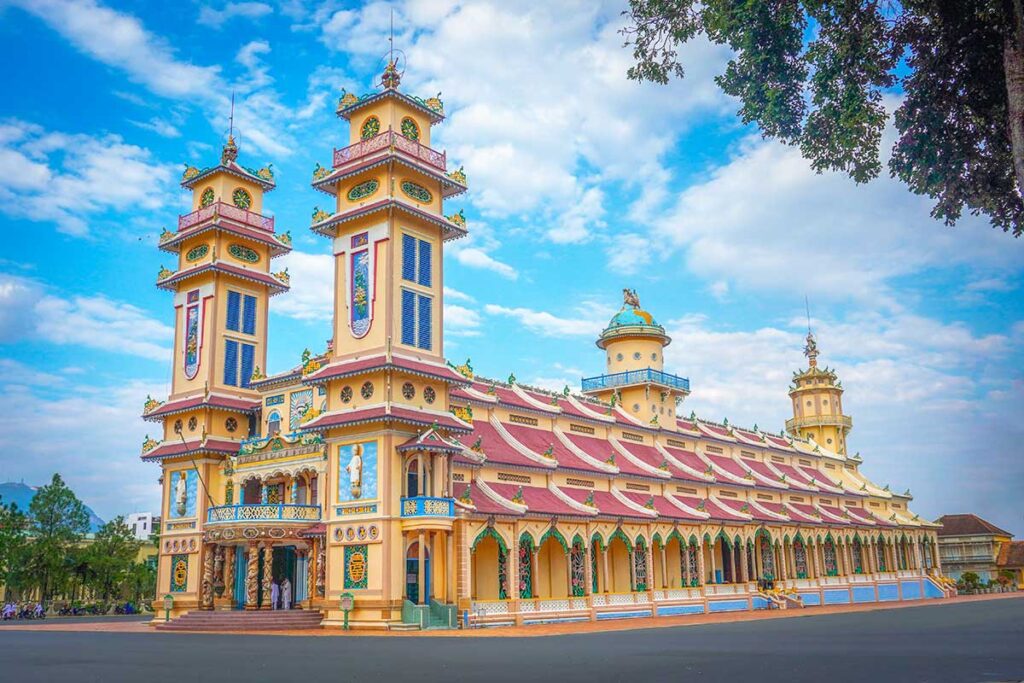
The centerpiece of the Holy See is the Great Divine Temple, an unusually colorful structure that mixes architectural influences from both East and West. Its façade is dominated by two tall towers and the giant Divine Eye symbol, representing God in the Caodaist faith. At first glance, the pastel colors and decorative details can feel over the top, but that is exactly what makes the building stand out.
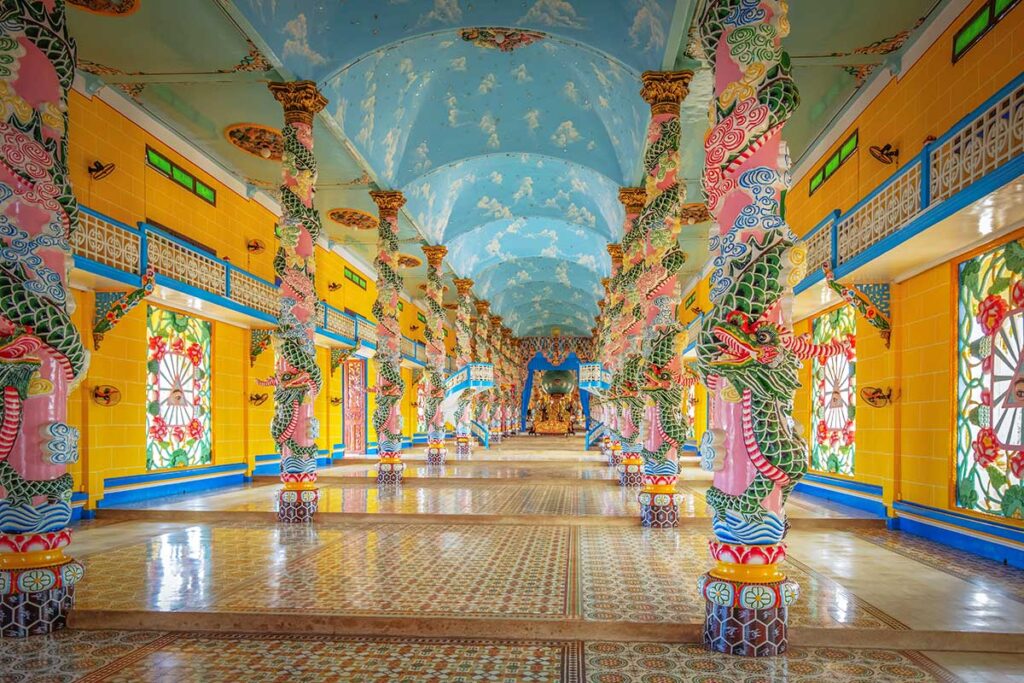
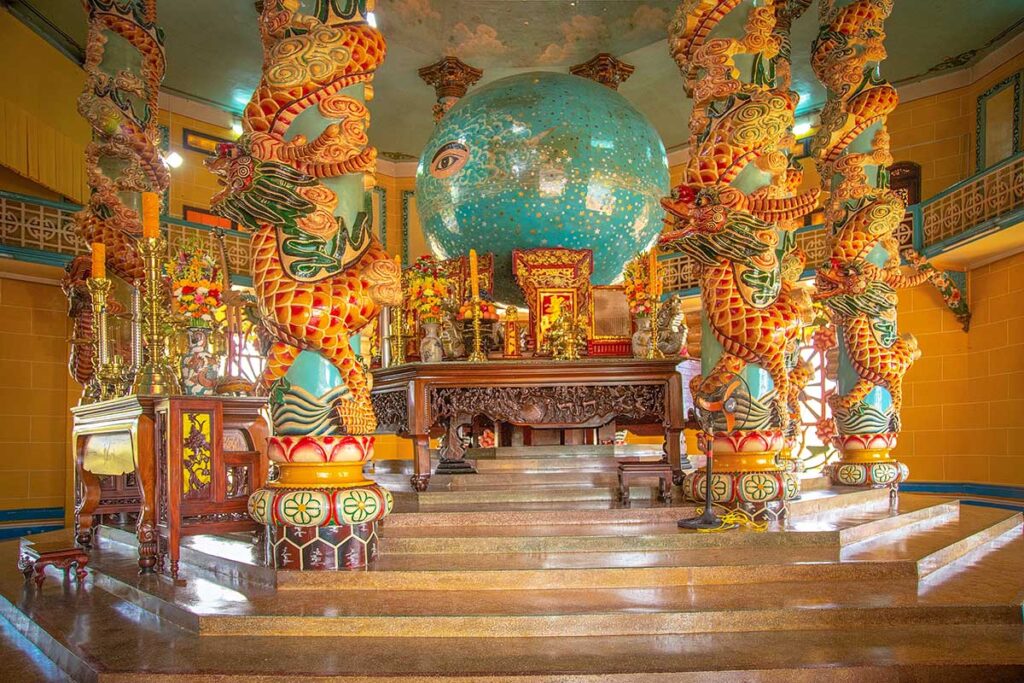
Inside, visitors walk along side aisles while ceremonies take place in the main hall. The interior is just as striking as the exterior: rows of pink columns wrapped with green dragons, a ceiling painted sky-blue with clouds and stars, and at the far end, a large globe featuring the Divine Eye. It’s a mix of Buddhist pagoda, Catholic cathedral, and Hindu temple aesthetics — unusual, sometimes even kitsch, but undeniably memorable.
2. Other Structures in the Complex
Beyond the main temple, the complex includes several other important buildings, though not all are open to tourists.
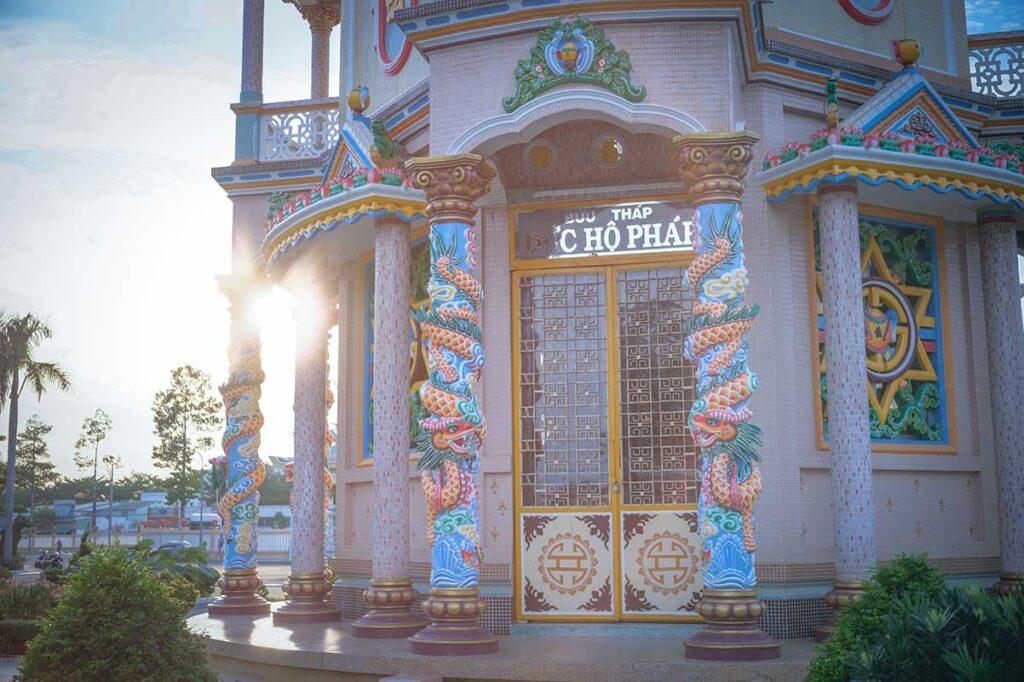
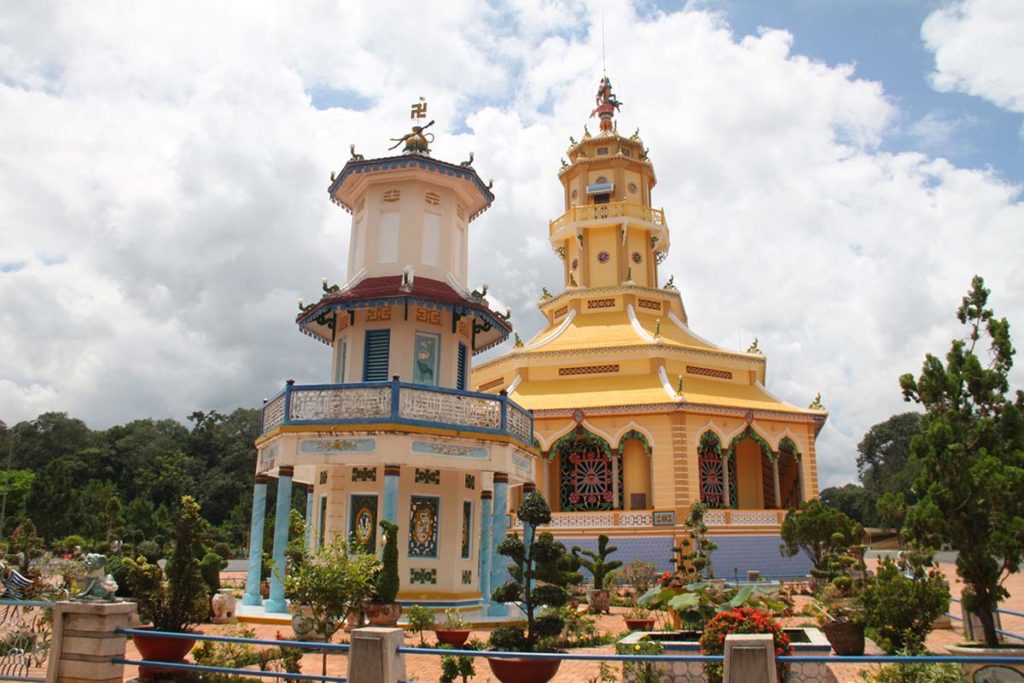
- Hiep Thien Dai – The “Palace of Union Between Heaven and Earth,” serving as the religious council hall, where legislative and judicial matters of the faith are handled.
- Cuu Trung Dai – The main hall, divided into nine levels that correspond to the hierarchy within Caodaism. This is where most major ceremonies take place.
- Bat Quai Dai – Considered the most sacred area of the entire site. Built in an octagonal shape, it represents universal harmony. Access here is restricted to clergy only.
- Long An Palace / museum area – A nearby building sometimes included as part of the visit. It houses exhibits related to the history of Caodaism and Tay Ninh. While not as visually striking as the temple, it adds context for travelers curious about the religion’s background.
3. Grounds & Surroundings
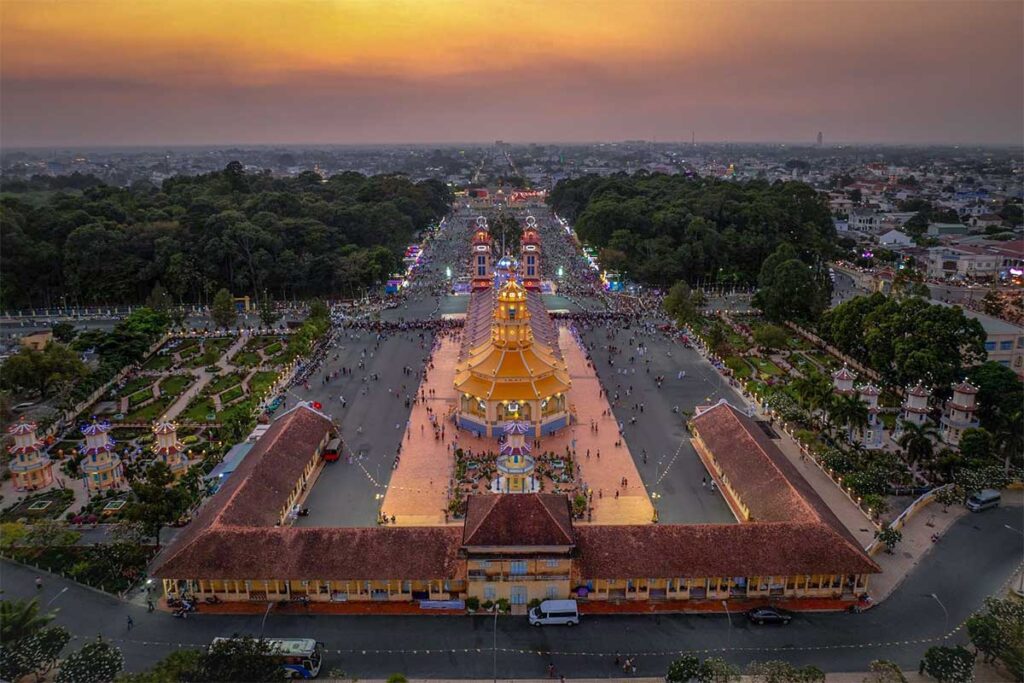
The Holy See sits on vast grounds that feel more like a small religious city than a single temple. Wide courtyards, long avenues, and well-kept gardens filled with potted plants and flowers surround the main hall. Strolling around gives you a better impression of the scale of the place.
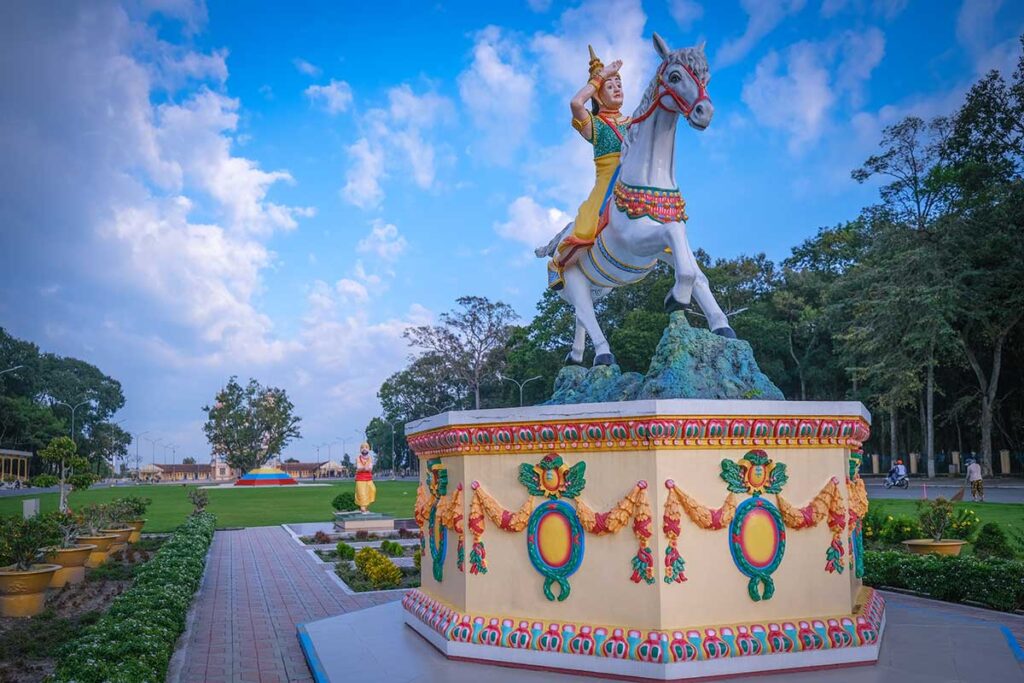
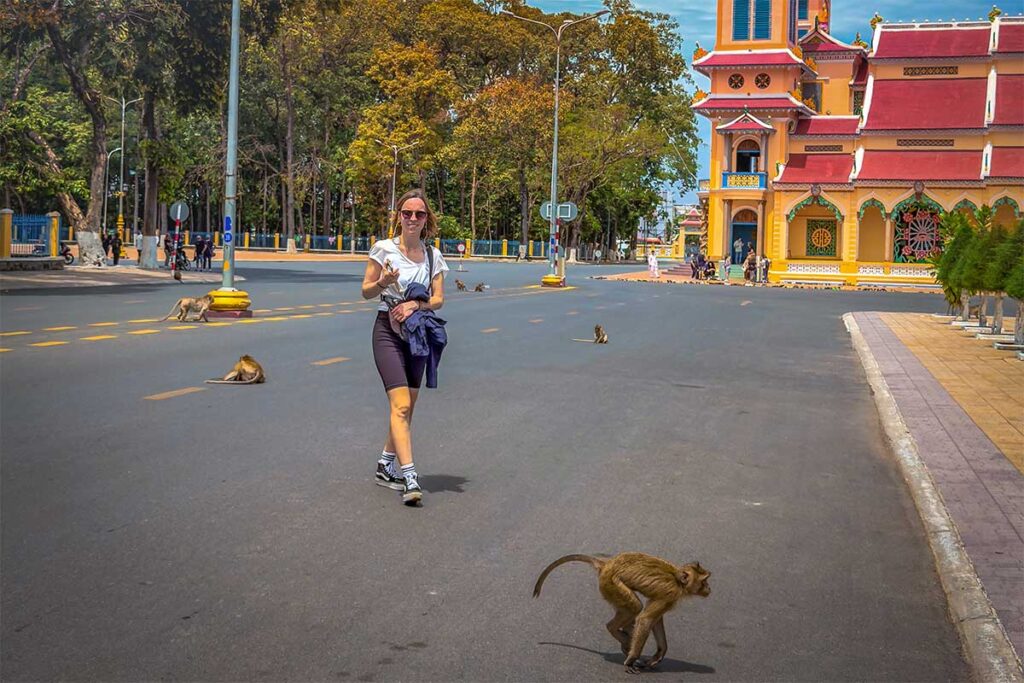
One practical thing to be aware of is the monkeys that live in the surrounding wooded areas. They sometimes roam into the courtyards and can be entertaining to watch, but they are also known to snatch food or shiny objects, so it’s best not to carry snacks in your hands.
Scattered around the compound are additional shrines and smaller buildings used for religious functions and housing the clergy. While tourists usually focus on the Great Divine Temple, exploring a bit further helps you understand that the Tay Ninh Holy See is an active religious hub, not just a tourist site.
Ceremonies at Tay Ninh Holy See
Attending a ceremony is often the most memorable part of visiting the Tay Ninh Holy See. The building itself is colorful and unusual, but seeing it filled with hundreds of worshippers in ritual dress gives you a real sense of the religion in practice.
Daily Prayers
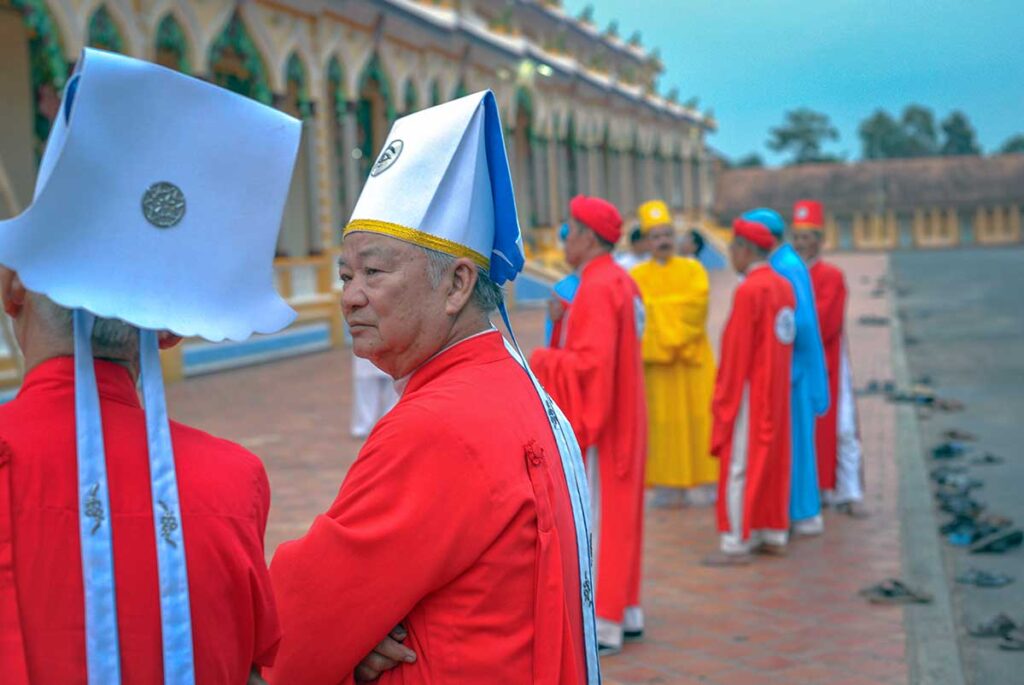
Ceremonies are held four times a day: at 6:00 in the morning, 12:00 noon, 18:00 in the evening, and midnight. The noon service is the most convenient and popular for visitors, as most tours from Ho Chi Minh City are timed to arrive shortly before it begins.
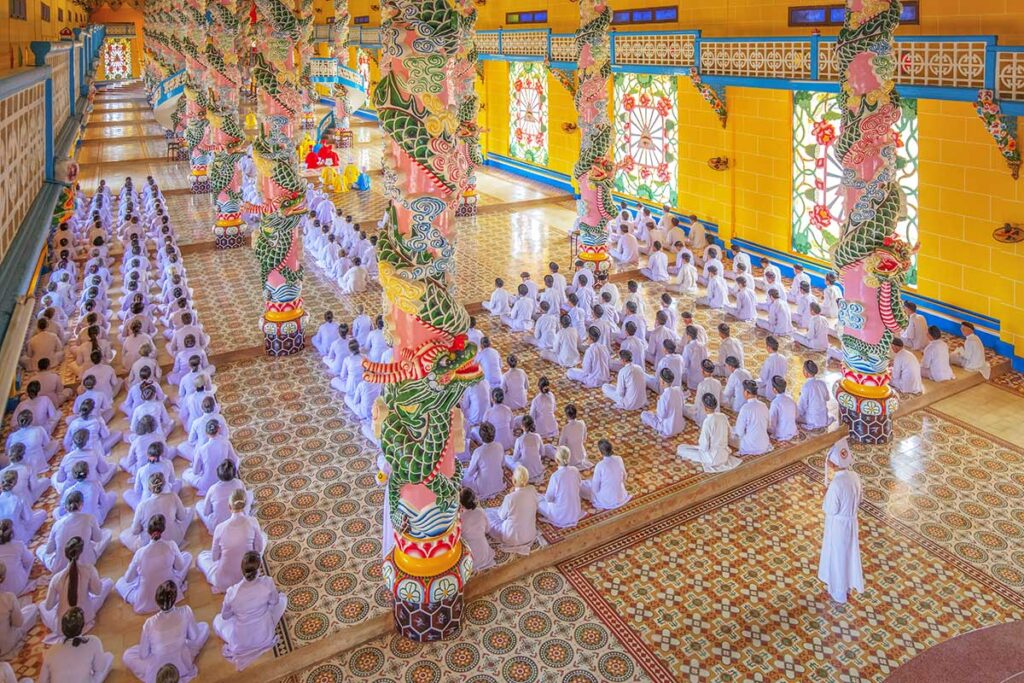
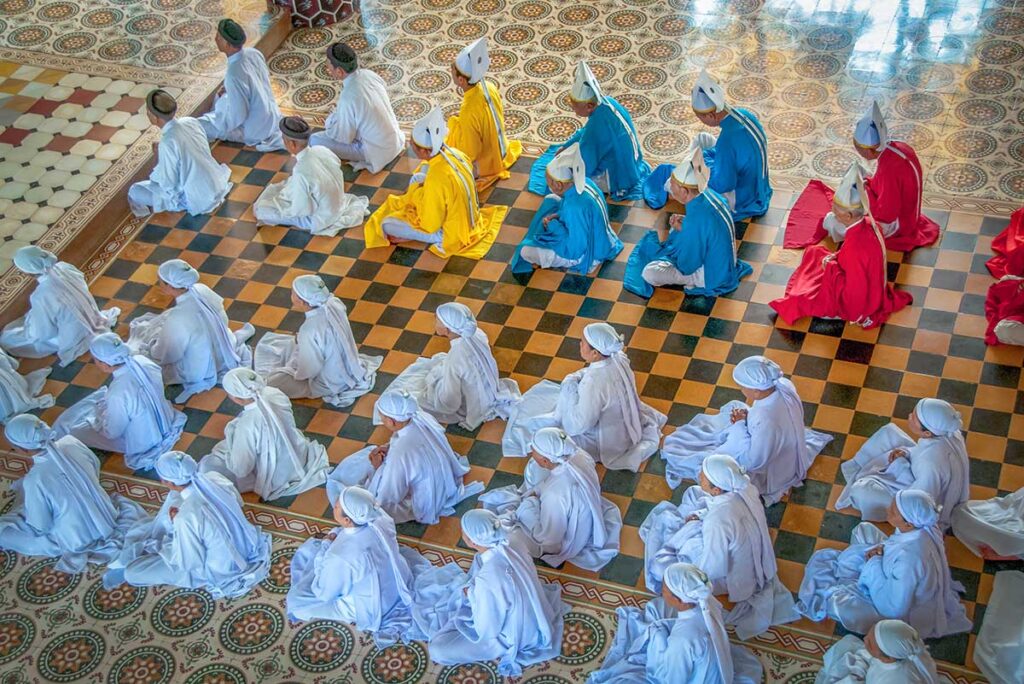
During the service, followers dressed in white robes kneel in rows on the temple floor, while priests in more elaborate yellow, red, and blue robes lead the prayers. The colors represent Buddhism, Confucianism, and Taoism — three of the main traditions that Caodaism incorporates. Tourists are not allowed to enter the central prayer area but can observe quietly from the side aisles or upstairs balcony. Photography is usually permitted, provided you remain respectful and silent.
Major Festivals
In addition to daily prayers, the Tay Ninh Holy See hosts large annual festivals that draw thousands of pilgrims from across Vietnam.
- Duc Chi Ton Festival (9th day of the 1st lunar month): This festival honors the Supreme Being, the highest deity in Caodaism. It includes processions, traditional music, and elaborate dances with mythical animals such as dragons, unicorns, and phoenixes. The atmosphere is busy, colorful, and celebratory.
- Holy Banquet for the Great Mother and Nine Goddesses (15th day of the 8th lunar month): This is one of the most important celebrations of the year, dedicated to the Divine Mother. The festival features parades, dragon dances, lanterns, and communal vegetarian meals shared by the community, symbolizing unity and devotion.
These festivals are impressive but also very crowded. If your trip coincides with one, it’s worth experiencing, but most travelers are content with witnessing a daily ceremony.
Practical visiting information & Travel tips
Visiting the Tay Ninh Holy See is straightforward, but a few practical details can make your trip smoother.
Opening Hours & Prayer Times
- The complex is open daily from 6:00 to 22:00.
- Ceremonies take place at 6:00, 12:00, 18:00, and midnight, with the noon prayer being the most popular for tourists.
Best time of day to bisit
- 12:00 noon – best if you want to see the main ceremony with full participation of priests and followers.
- Morning or late afternoon – better if you prefer cooler weather and quieter grounds, though ceremonies are smaller.
Dress Code & Conduct
- Wear modest clothing: no shorts, sleeveless tops, or miniskirts.
- Remove shoes and hats before entering the temple.
- Stay in the designated visitor areas and do not step into the prayer section.
- Photography is generally allowed, but use common sense: be discreet, turn off flash, and avoid blocking worshippers.
Common Issues & Tips
- Some staff or guards can be quite strict with rules. To avoid unpleasant interactions, follow signs and observe where other tourists stand.
- Monkeys roam the outer grounds. They may look playful but will steal food or shiny objects if given the chance.
Combine with other sights
Most visitors combine a trip to the Holy See with nearby attractions to make the long drive from Ho Chi Minh City more worthwhile:
- Cu Chi Tunnels – located on the way from Saigon, often paired with a noon prayer visit at the Holy See.
- Ba Den (Black Virgin) Mountain – a popular Tay Ninh pilgrimage site with a cable car and hiking trails.
- Optional extras: Dau Tieng Lake for a quiet countryside stop, or trying Tay Ninh specialties like Trang Bang dew-wetted rice paper and the province’s famous shrimp salt.
Other Cao Dai Temples in Vietnam
The Tay Ninh Holy See is the headquarters and by far the most impressive Cao Dai temple, but smaller versions can be found in other parts of Vietnam. These include temples in the Mekong Delta, Phu Quoc, and Da Nang. They have the same colorful style but are much smaller, and often don’t allow visitors to observe ceremonies as freely.
How to get to Cao Dai Temple in Tay Ninh
The Tay Ninh Holy See is about 100 kilometers northwest of Ho Chi Minh City. On paper it looks like a short trip, but traffic and road conditions mean it usually takes between 2 and 3 hours each way.
Location & Address
The temple complex is located on Pham Ho Phap Street, Long Hoa Ward, Hoa Thanh Town, Tay Ninh Province. It’s around 6 kilometers southeast of Tay Ninh city center and close to Ba Den Mountain.
By Tour
The easiest option for most travelers is to join a tour from Ho Chi Minh City. Almost all tours combine a stop at the Cu Chi Tunnels with the noon ceremony at the Holy See.
- Group (join-in) tours are the cheapest and most convenient if you just want transport and a guide for the day.
- Private tours are more expensive but allow you to adjust the timing and often include extras like Ba Den Mountain or local food stops.
Private Car with Driver
If you don’t want a full tour, you can hire a private car with driver for a flexible day trip. This works well if you already know what you want to see — for example, combining the Holy See with Ba Den Mountain. Just keep in mind that the driver is not a guide, so it’s more of a transfer service. Entrance fees or cable car tickets are not included.
By motorbike
For experienced riders with a license, doing the trip by motorbike is possible, but it’s a long and tiring ride. Expect 2–3 hours each way in heavy traffic, plus hot or rainy weather depending on the season. For less experienced riders, it’s not recommended.
By bus
There are public buses running from Ho Chi Minh City (An Suong Bus Station) to Tay Ninh. While inexpensive, they are less convenient for foreign tourists because of the language barrier and the extra steps required to get from Tay Ninh city to the temple itself. Unless you’re comfortable with Vietnamese public transport, most travelers find a tour or private car much easier.
Is the Cao Dai Holy See in Tay Ninh worth visiting?
The Tay Ninh Holy See is certainly unique — there’s no other temple in Vietnam that looks quite like it. The mix of architectural styles, the bright colors, and the sight of hundreds of followers in white robes during prayer make it a memorable place to see. Even if you’ve visited many temples across Asia, this one still feels different.
That said, the visit itself is usually quite short compared to the travel time. Most tourists spend around an hour inside the temple and walking the grounds, while the drive from Ho Chi Minh City takes two to three hours each way. For that reason, the Holy See makes the most sense as part of a combo trip, typically with the Cu Chi Tunnels or Ba Den Mountain. On its own, the long journey may feel disproportionate to the time you’ll spend at the temple.
In short: if you’re curious about Caodaism or enjoy unusual religious architecture, the Tay Ninh Holy See is worth visiting — but plan to combine it with another nearby highlight to make the day more worthwhile.
